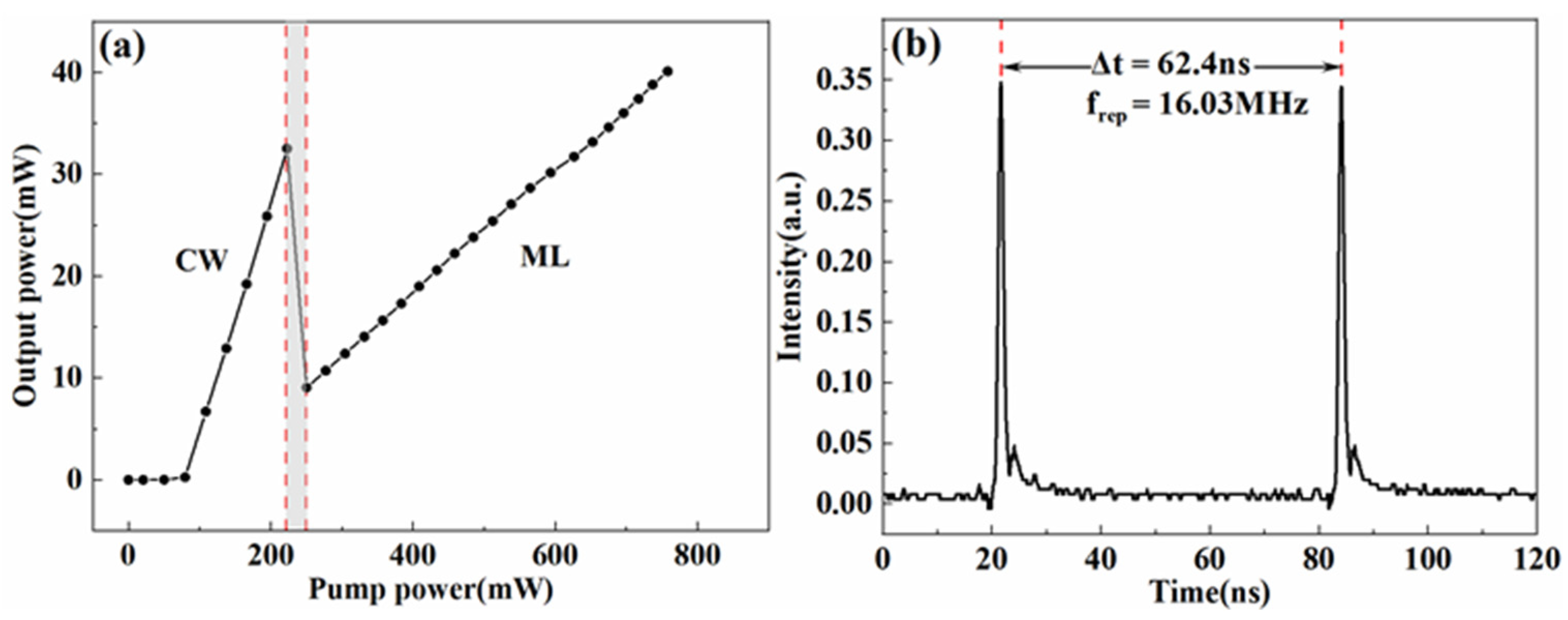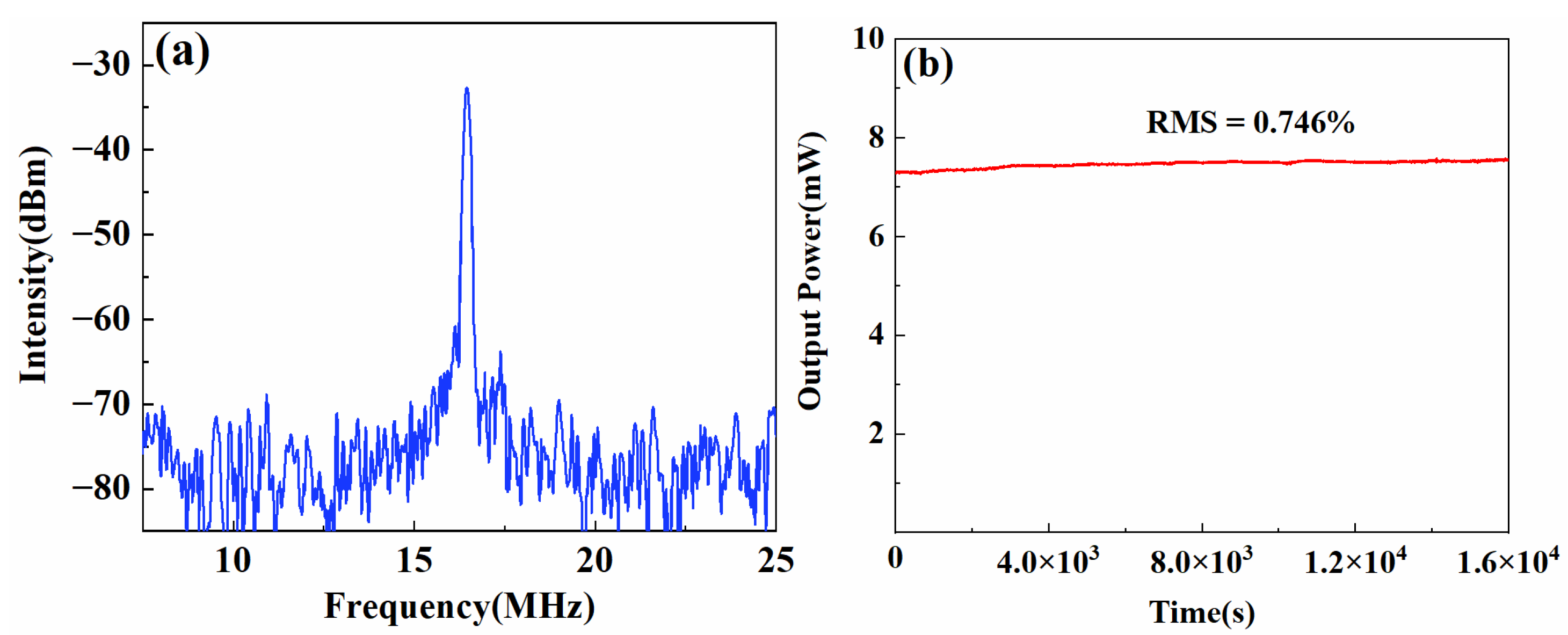Generation of 99.8 fs, 25 kW Peak-Power, Dispersion-Managed Pulses Directly from an Yb-Doped Figure-of-9 Fiber Laser
Abstract
1. Introduction
2. Experimental Setup
3. Results and Discussion
4. Conclusions
Author Contributions
Funding
Institutional Review Board Statement
Informed Consent Statement
Data Availability Statement
Conflicts of Interest
References
- Russbueldt, P.; Mans, T.; Weitenberg, J.; Hoffmann, H.D.; Poprawe, R. Compact diode-pumped 1.1 kW Yb:YAG Innoslab femtosecond amplifier. Opt. Lett. 2010, 35, 4169–4171. [Google Scholar] [CrossRef]
- Müller, M.; Aleshire, C.; Klenke, A.; Haddad, E.; Légaré, F.; Tünnermann, A.; Limpert, J. 10.4 kW coherently combined ultrafast fiber laser. Opt. Lett. 2020, 45, 3083–3086. [Google Scholar] [CrossRef]
- Aguergaray, C.; Broderick, N.; Erkintalo, M.; Chen, J.; Kruglov, V. Mode-locked femtosecond all-normal all-PM Yb-doped fiber laser using a nonlinear amplifying loop mirror. Opt. Express 2012, 20, 10545. [Google Scholar] [CrossRef]
- Liu, W.; Shi, H.; Cui, J.; Xie, C.; Song, Y.; Wang, C.; Hu, M. Single-polarization large-mode-area fiber laser mode-locked with a nonlinear amplifying loop mirror. Opt. Lett 2018, 43, 2848–2851. [Google Scholar] [CrossRef]
- Nicholson, J.W.; Andrejco, M. A polarization maintaining, dispersion managed, femtosecond figure-eight fiber laser. Opt. Express 2006, 14, 8160. [Google Scholar] [CrossRef]
- Xu, B.; Martinez, A.; Set, S.Y.; Goh, C.S. Polarization Maintaining, Nanotube-Based Mode-Locked Lasing From Figure of Eight Fiber Laser. IEEE Photonics Technol. Lett. 2014, 26, 180–182. [Google Scholar] [CrossRef]
- Bowen, P.; Erkintalo, M.; Provo, R.; Harvey, J.D.; Broderick, N. Mode-locked Yb-doped fiber laser emitting broadband pulses at ultralow repetition rates. Opt. Lett. 2016, 41, 5270. [Google Scholar] [CrossRef]
- Yang, Y.; Hao, T.; Huibo, W.; Lina, W.; Jiangfeng, Z.; Shaobo, F.; Guoqing, C.; Junli, W.; Zhiyi, W. Highly-stable mode-locked PM Yb-fiber laser with 10 nJ in 93-fs at 6 MHz using NALM. Opt. Express 2018, 26, 10428. [Google Scholar]
- Jiang, T.; Cui, Y.; Lu, P.; Li, C.; Wang, A.; Zhang, Z. All PM Fiber Laser Mode Locked With a Compact Phase Biased Amplifier Loop Mirror. IEEE Photonics Technol. Lett. 2016, 28, 1786–1789. [Google Scholar] [CrossRef]
- Kuse, N.; Jiang, J.; Lee, C.C.; Schibli, T.R.; Fermann, M.E. All polarization-maintaining Er fiber-based optical frequency combs with nonlinear amplifying loop mirror. Opt. Express 2016, 24, 3095–3102. [Google Scholar] [CrossRef]
- Hänsel, W.; Hoogland, H.; Giunta, M.; Schmid, S.; Steinmetz, T.; Doubek, R.; Mayer, P.; Dobner, S.; Cleff, C.; Fischer, M.; et al. All polarization-maintaining fiber laser architecture for robust femtosecond pulse generation. Appl. Phys. B 2017, 123, 41. [Google Scholar] [CrossRef]
- Hong, L.; Donald, D.K.; Sorin, W.V. Optimizing polarization states in a figure-8 laser using a nonreciprocal phase shifter. J. Lightwave Technol. 1994, 12, 1121–1128. [Google Scholar] [CrossRef]
- Edelmann, M.; Hua, Y.; Koch, A.; Kärtner, F.X. Generation of 64 fs, 10 kW peak-power, transform-limited pulses directly from an Yb-doped Figure-9 fiber laser. In Proceedings of the CLEO: Science and Innovations 2020, Washington, DC, USA, 10–15 May 2020. [Google Scholar]
- Chu, H.; Zhao, S.; Li, G.; Li, M.; Li, D. Mode-locked femtosecond polarization-maintaining Yb-doped fiber laser with a figure-nine configuration. Opt. Commun. 2021, 482, 126595. [Google Scholar] [CrossRef]
- Lan, Y.; Song, Y.; Hu, M.; Liu, B.; Chai, L.; Wang, C. Enhanced spectral breathing for sub-25 fs pulse generation in a Yb-fiber laser. Opt. Lett. 2013, 38, 1292–1294. [Google Scholar] [CrossRef] [PubMed]
- Mortag, D.; Wandt, D.; Morgner, U.; Kracht, D.; Neumann, J. Sub-80-fs pulses from an all-fiber-integrated dissipative-soliton laser at 1 µm. Opt. Express 2011, 19, 546–551. [Google Scholar] [CrossRef]
- Kieu, K.; Renninger, W.H.; Chong, A.; Wise, F.W. Sub-100 fs pulses at watt-level powers from a dissipative-soliton fiber laser. Opt. Lett. 2009, 34, 593–595. [Google Scholar] [CrossRef]
- Chi, H.; Liu, B.; Song, Y.; Hu, M.; Chai, L.; Shen, W.; Liu, X.; Wang, C. Nonlinearity optimization of dissipative-soliton fiber laser for generation of pulses with 350 kW peak power. High Power Laser Sci. Eng. 2018, 6, e27. [Google Scholar] [CrossRef]
- Yatsu, R.; Taira, K.; Tsuchiya, M. High-quality sub-100-fs optical pulse generation by fiber-optic soliton compression of gain-switched distributed-feedback laser-diode pulses in conjunction with nonlinear optical fiber loops. Opt. Lett. 1999, 24, 1172–1174. [Google Scholar] [CrossRef]
- Luo, D.; Li, W.; Liu, Y.; Wang, C.; Zhu, Z.; Zhang, W.; Zeng, H. High-power self-similar amplification seeded by a 1 GHz harmonically mode-locked Yb-fiber laser. Appl. Phys. Express 2016, 9, 082702. [Google Scholar] [CrossRef]
- Daniault, L.; Hanna, M.; Papadopoulos, D.N.; Zaouter, Y.; Mottay, E.; Druon, F.; Georges, P. High peak-power stretcher-free femtosecond fiber amplifier using passive spatio-temporal coherent combining. Opt. Express 2012, 20, 21627–21634. [Google Scholar] [CrossRef]
- Mok, J.T.; Littler, I.C.M.; Tsoy, E.; Eggleton, B.J. Soliton compression and pulse-train generation by use of microchip Q-switched pulses in Bragg gratings. Opt. Lett. 2005, 30, 2457–2459. [Google Scholar] [CrossRef] [PubMed]
- Zhang, L.; El-Damak, A.R.; Feng, Y.; Gu, X. Experimental and numerical studies of mode-locked fiber laser with large normal and anomalous dispersion. Opt. Express 2013, 21, 12014–12021. [Google Scholar] [CrossRef] [PubMed]
- Treacy, E. Optical pulse compression with diffraction gratings. IEEE J. Quantum Electron. 1969, 5, 454–458. [Google Scholar] [CrossRef]
- Wang, L.; Xu, P.; Li, Y.; Han, J.; Guo, X.; Cui, Y.; Liu, X.; Tong, L. Femtosecond Mode-locked Fiber Laser at 1 μm Via Optical Microfiber Dispersion Management. Sci. Rep. 2018, 8, 4732. [Google Scholar] [CrossRef] [PubMed]
- Liu, G.; Wang, A.; Zhang, Z. 84-fs 500-MHz Yb:Fiber-Based Laser Oscillator Mode Locked by Biased NALM. IEEE Photonics Technol. Lett. 2017, 29, 2055–2058. [Google Scholar] [CrossRef]
- Liu, G.; Jiang, X.; Wang, A.; Chang, G.; Kartner, F.; Zhang, Z. Robust 700 MHz mode-locked Yb:Fiber laser with a biased nonlinear amplifying loop mirror. Opt. Express 2018, 26, 26003. [Google Scholar] [CrossRef]
- Shi, Y.; Peng, Z.; Cheng, Z.; Xia, T.; Zhao, H.; Wan, S.; Wang, P. All-Fiber Polarization-Maintaining Dispersion-Managed Figure-of-9 Mode-Locked Laser. IEEE Photonics Technol. Lett. 2022, 34, 251–254. [Google Scholar] [CrossRef]
- Guo, Z.; Hao, Q.; Yang, S.; Liu, T.; Hu, H.; Zeng, H. Octave-Spanning Supercontinuum Generation From an NALM Mode-Locked Yb-Fiber Laser System. IEEE Photonics J. 2017, 9, 1–7. [Google Scholar] [CrossRef]




| Ref | Spectral Width | Pulse Duration | Pulse Energy | Peak-Power |
|---|---|---|---|---|
| [26] | 31 nm | 61 fs | 0.1 nJ | 1.5 kW |
| [27] | 7.8 nm | 215 fs | 0.21 nJ | 0.4 kW |
| [28] | 20 nm | 1.86 ps | 0.26 nJ | 0.14 kW |
| [14] | 14.1 nm | 122 fs | 0.61 nJ | 4.85 kW |
| [13] | NA | 64 fs | NA | 10 kW |
| This work | 12.06 nm | 99.8 fs | 2.5 nJ | 25 kW |
Publisher’s Note: MDPI stays neutral with regard to jurisdictional claims in published maps and institutional affiliations. |
© 2022 by the authors. Licensee MDPI, Basel, Switzerland. This article is an open access article distributed under the terms and conditions of the Creative Commons Attribution (CC BY) license (https://creativecommons.org/licenses/by/4.0/).
Share and Cite
Yuan, S.; Si, L.; Chen, J.; Chen, J.; Yu, H. Generation of 99.8 fs, 25 kW Peak-Power, Dispersion-Managed Pulses Directly from an Yb-Doped Figure-of-9 Fiber Laser. Materials 2022, 15, 7038. https://doi.org/10.3390/ma15197038
Yuan S, Si L, Chen J, Chen J, Yu H. Generation of 99.8 fs, 25 kW Peak-Power, Dispersion-Managed Pulses Directly from an Yb-Doped Figure-of-9 Fiber Laser. Materials. 2022; 15(19):7038. https://doi.org/10.3390/ma15197038
Chicago/Turabian StyleYuan, Shuai, Lu Si, Jianing Chen, Junyu Chen, and Han Yu. 2022. "Generation of 99.8 fs, 25 kW Peak-Power, Dispersion-Managed Pulses Directly from an Yb-Doped Figure-of-9 Fiber Laser" Materials 15, no. 19: 7038. https://doi.org/10.3390/ma15197038
APA StyleYuan, S., Si, L., Chen, J., Chen, J., & Yu, H. (2022). Generation of 99.8 fs, 25 kW Peak-Power, Dispersion-Managed Pulses Directly from an Yb-Doped Figure-of-9 Fiber Laser. Materials, 15(19), 7038. https://doi.org/10.3390/ma15197038






